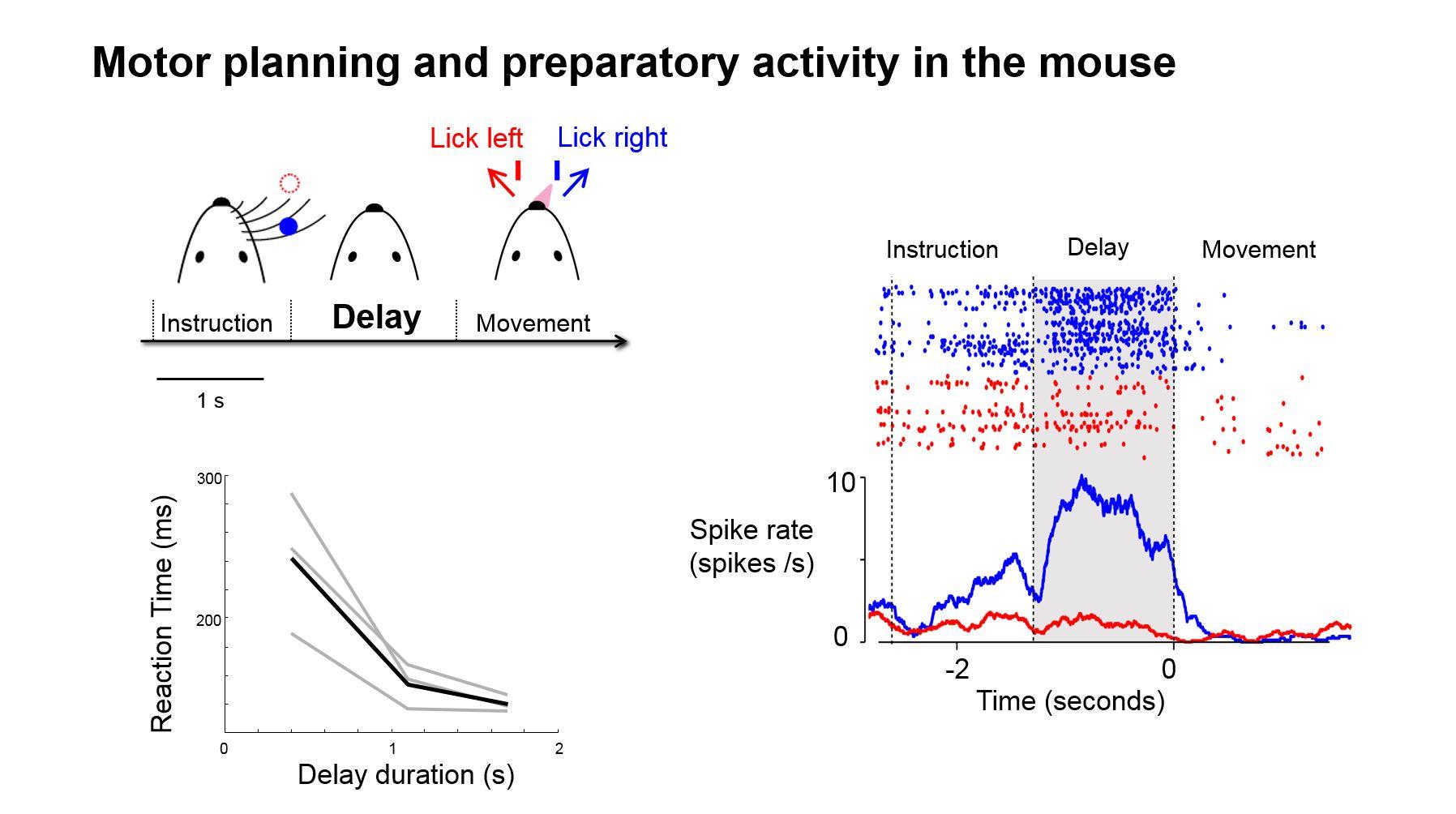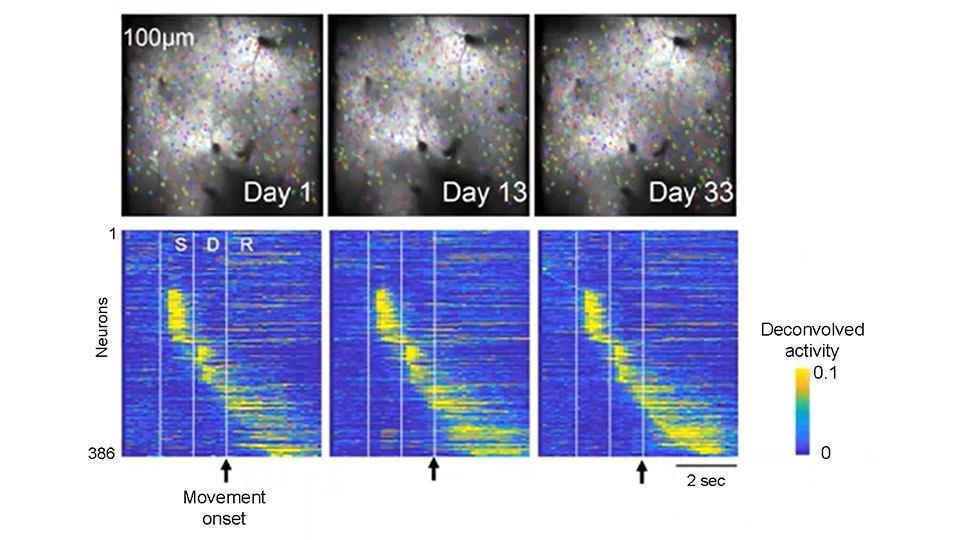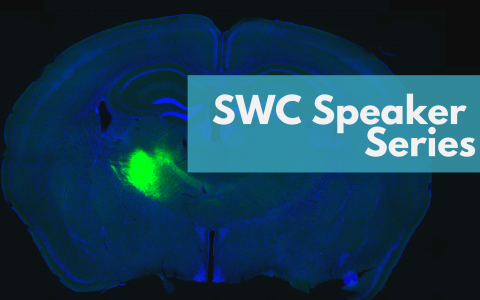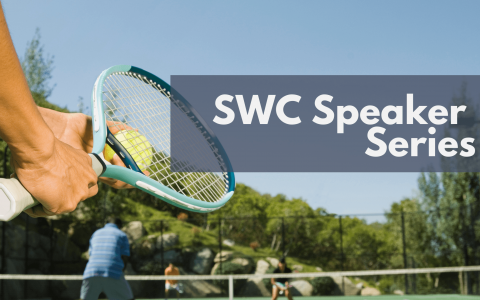
Ready, set, go
An interview with Dr Nuo Li, Duke University, conducted by Alison Cranage
You never forget how to ride a bike. Or any other movement-based skill, for that matter. But how does the brain store these kinds of memories? And how do new skills not overwrite older ones? These questions are driving the work of Dr Nuo Li, Associate Professor of Neurobiology at Duke University.
In a recent SWC seminar, Dr Li discussed his work on the brain circuits that give rise to voluntary movements. In experiments with mice trained to lick in different directions depending on a cue, his team has uncovered ‘preparatory states’ - patterns of neural activity that emerge before movement begins. Crucially, they found that for the same physical action, like licking left, the preparatory pattern depends on the context. The brain creates multiple, context-specific states for the same action, which are stored in parallel, and are surprisingly stable over time.
In this Q&A, Li talks about his work and its implications for understanding how we learn new skills, and his hopes for helping people with movement disorders.
Your lab studies the neural mechanisms of movement planning and decision making. How would you explain the big question that your work is trying to address?
I think ‘decision-making’ and ‘cognitive function’ are very abstract. I'm gravitating more and more toward the notion that my lab is really studying tongue control.
The tongue is a very mysterious organ. It's a hydrostat - it doesn't have any bones. It's full of muscles. It's the most dexterous organ in your body. It makes so many shapes, but we understand very little about how it does this, and very little about how the brain controls the tongue.
My work looks at high-level, goal-directed voluntary control. We also look at the low-level control that happens without us thinking about it - for breathing, eating and so on.
When animals lick to drink, we have shown that they make a rhythmic movement, controlled by the brainstem, which is tied to breathing. Which makes sense because when you're drinking, you gather the water in your mouth, and then you swallow - that needs to be coordinated with how you breathe. That’s not something you voluntarily control. It's built into the circuit.
We are studying licking behaviour in rodents to look at both types of movement. We aim to understand some of these really fundamental movement functions.
Your work has uncovered how the brain stores contextual versions of movement skills, like multiple modules of a memory. Can you talk us through how you identified those modules, and what defines the context in this case?
We're using a simple tongue-licking task where the animal has to lick left or right, depending on the cue they receive. They performed these same licks in different settings. In one setting, they learn one rule. There, we see a pattern of activity in the brain, a signal which represents the animal's action plan. It represents what they're going to do a few seconds or milliseconds into the future.
Then, we train the animals with a new rule. The actions they perform, the lick left or lick right, are the same, but the context is different. And we found that the preparatory activity pattern in the brain looks completely different in the different settings.
So in some sense, the brain is making a new representation of a skill in each different context.
I think this reveals something inherent about the brain and how we learn. Let's say you learn to play the piano. You learn, and you always play it in the same setting. If you go to a different setting, you would actually be worse at performing, even though your surroundings are inconsequential to the actions you need to play. How you learn is tied to a context signal, which is what a lot of your motor behaviours are based on.
So that's one way to build a generalizable skill – go to new settings and perform it. If you just do it in one place, it's very hard to generalise.
Context in this case is broadly defined - it's the environment and the setting around you. When you're sitting down in front of a computer, you have your hands on the keyboard, then immediately your brain is activating this context signal that brings to you actions for typing different words. Goal-directed actions relate to the notion of what you are doing, what the environment is, and what you're doing within it, and that would bring forward a set of potential actions that are available to you, and you're then rapidly selecting the appropriate ones.

Figure showing motor planning and preparatory activity in the mouse.
How stable are these neural representations of movement, especially over long periods of time?
This was very surprising to us. They were stable over three months in a mouse – that’s the equivalent of 20 years of a human lifetime.
It’s way beyond the lifetime for the biological hardware that makes up brain cells and synapses. The proteins that build the hardware only last a few days or weeks. It’s a holy grail in neuroscience, though – we’re not the only ones investigating how long-term memories are maintained - but I think the motor system is a great system to study this question.

Figure showing the stability of neural representations of movement planning.
What are the challenges in teasing apart these neural representations of movement planning, versus representations of the movement itself, or other signals?
The teasing apart of a different set of signals really requires careful task manipulations.
We found this particular signal, which is the animal's future action plan. But at the same time, there were signals about context. There are also overlapping signals about the sensory stimulus. We have all these different signals represented simultaneously in the same neural network.
What really benefited our studies is advancing computational neuroscience methods. Using these, we can de-mix signals through dimensionality reduction.
Those methods are necessary for us to have the level of understanding we have today. We’ve moved away from looking at the activity of single neurons to really understanding the signals that are represented in a population of cells, and being able to resolve them.
You still need validation, which is where careful task manipulations are applied to very specific variables, so we can see how these signals change. We are beginning to resolve some of the signals that are driving behaviour.
What makes these studies a good window into how the brain works more broadly?
For high-level tongue control, I think some of the principles we study could reveal some principles about how goal-directed behaviours are generated.
We're looking at a time window of just a few hundred milliseconds before the first measurable behavioural outcome. As we're behaving, we are taking actions. That's our overt motor output. We're using behaviour as a starting point and looking backwards to see what led to the formation of those actions.
It's an interesting observation that most of the brain regions that are involved in cognition are also the regions that control the body. I don't think that's an accident. I think our cognition evolved from our motor behaviour. So I think it's a nice system to use as an entryway to study the principles of cognition.
Would we be able to have normal cognition without the ability to move? There is a school of thought that cognition is inherently embedded in a sensory motor loop between ourselves, our actions and the world. In that feedback loop, what we do would actually influence how we think. This notion is embodied cognition. So, as you are moving, what you're doing is represented in the neural activity - is that necessary then for triggering the next mental experience?
I don't have an answer. But it is fascinating to think about.
You’ve found cerebellar regions are involved in the movement preparation - was that a surprise?
We were not surprised to see the cerebellum involved. It’s classically known to be a structure controlling movement.
But what we were surprised by was the kind of organisation it has with the frontal cortex. It's long been thought that these two regions have a topographical structure, meaning regions between the two connect 1:1 to each other. One spot in the cerebellum might project back to one spot in the frontal cortex, forming a loop with a specific function. But that's not what we found at all.
Instead, we found that one region in the frontal cortex goes to a lot of regions in the cerebellum, and vice versa. That architecture seems to be very different from a lot of other brain structures. It's almost like a switchboard. From the cerebellum, you can traverse anywhere. It’s unique.
We think this means that if you do a different task that requires different cortical regions, the cerebellum is going to allow you to form functional networks that are capable of learning different associations. Of course, that remains to be tested, but it's our hypothesis at the moment.
What are the implications of your work for understanding motor disorders?
There is a class of problems with tongue control that isn’t to do with goal-directed, voluntary control, but automatic control, and these can be fatal. In most neurological disorders, like Alzheimer’s and Parkinson’s, the leading cause of death is aspiration pneumonia. This stems from insufficient control of the ingestion of food and liquid, and swallowing. A lot of that traces to a tongue control problem. In the advanced stages of Alzheimer’s and Parkinson's, people have trouble with swallowing - food gets into the lungs and they develop pneumonia.
We’ve found that a lot of these mechanics, motor control of the tongue movement during swallowing and breathing, are controlled by the brainstem. There is a central pattern generator in the brainstem that controls the tongue, and that interacts with another central pattern generator, controlling breathing.
We are increasingly interested in that circuit. In most animal models of Alzheimer's and Parkinson's, the dynamics in those circuits are messed up.
We want to get at the cell types that are involved in these circuits. If we can identify those, we may be able to boost their functions. That's an aspirational goal at the moment.
What are you focusing on next in your research?
We are really expanding our work on the brainstem. We've already identified the regions that control tongue movements. It is super exciting to see that.

Biography
Nuo Li is Associate Professor of Neurobiology at Duke University. He did his PhD work with Jim DiCarlo at MIT to examine how the primate visual system constructs invariance object representations. For his postdoctoral work with Karel Svoboda at Janelia Research Campus, he contributed to the development of head-fixed behavioral paradigm in mice. His lab developed tools to study brain-wide circuits in the mouse supporting volitional movement. This work established anterior lateral motor cortex (ALM) important for decision-making and motor planning. His recent work found that the cerebellum contributes to cognitive processes by reciprocally interacting with the frontal cortex. His work has been recognized with numerous awards, including Society for Neuroscience Young Investigator Award and NIH Director’s Pioneer Award.

